Stefano Boeri's "vertical forest" nears completion in Milan
News: a pair of skyscrapers by Milan office Boeri Studio are nearing completion in the Italian city, featuring as many trees as could be planted in a hectare of forest.
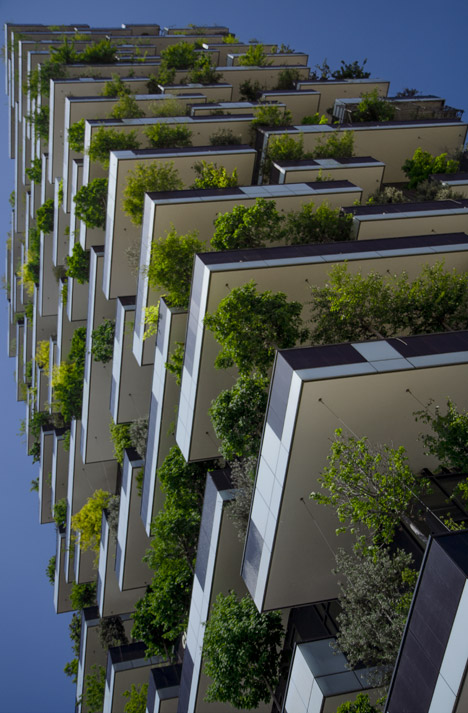
The studio led by Italian architect Stefano Boeri came up with the concept of Bosco Verticale, or Vertical Forest, as a way to combine high-density residential development with tree planting in city centres.
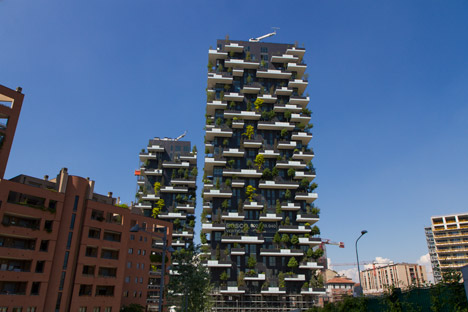
The first project born from this concept is now nearing completion in the Isola area of Milan's fast-developing Porta Nuova district. Two towers, measuring 80 and 112 metres, are set to open later this year and are already home to 900 trees.
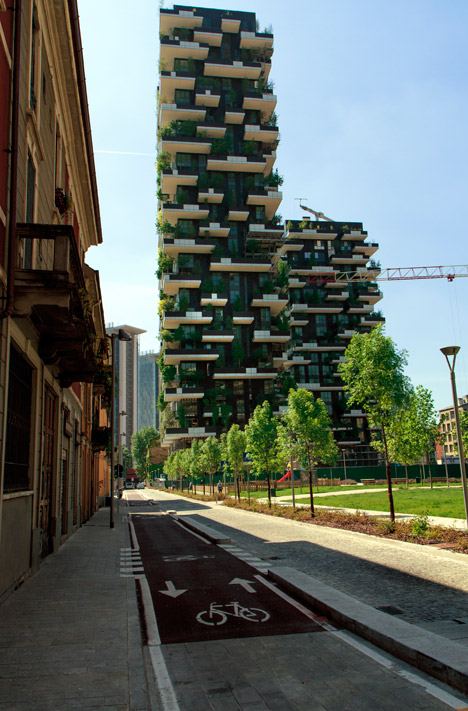
"The project is set to create a new standard for sustainable housing," said engineering firm Arup, who is working alongside Boeri Studio to deliver the project.
"As a new growth model for the regeneration of the urban environment, the design creates a biological habitat in a total area of 40,000 square metres."
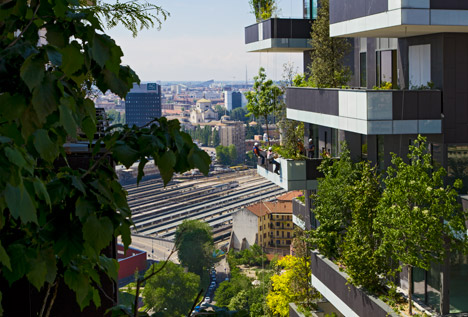
A mixture of large and small trees have been planted on balconies on all four sides of the towers, accompanied by 5,000 shrubs and 11,000 floral plants. The design team claim these will absorb dust in the air, helping to depollute the city.
"This is a kind of biological architecture that refuses to adopt a strictly technological and mechanical approach to environmental sustainability," said Boeri Studio in a statement.

The diverse vegetation will provide urban habitats for birds and insects, and will also create a humid micro-climate that produces oxygen whilst shading residences from harsh sunlight.
"The creation of a number of vertical forests in the city will be able to create a network of environmental corridors which will give life to the main parks in the city, bringing the green space of avenues and gardens and connecting various spaces of spontaneous vegetation growth," said the studio.
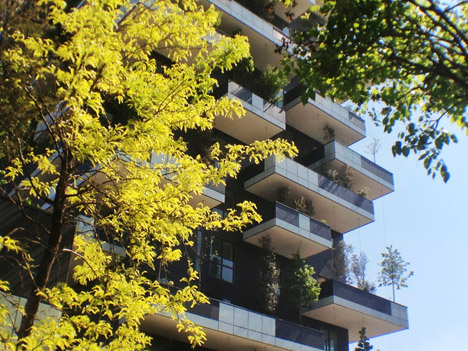
Photography is by Daniele Zacchi.
Here's a project description from Boeri Studio:
Bosco Verticale/Vertical Forest
The Vertical Forest project aims to build high-density tower blocks with trees within the city. The first example of a Vertical Forest is currently under construction in Milan in Porta Nuova Isola area, part of a larger redevelopment project developed by Hines Italia with two towers which are 80 metres and 112 metres tall respectively, and which will be able to hold 480 big and medium size trees, 250 small size trees, 11.000 groundcover plants and 5.000 shrubs (the equivalent of a hectare of forest).
The Vertical Forest has at its heart a concept of architecture which demineralises urban areas and uses the changing shape and form of leaves for its facades, and thus which hands over to vegetation itself the task of absorbing the dust in the air, and of creating an adequate micro-climate in order to filter out the sunlight. This is a kind of biological architecture which refuses to adopt a strictly technological and mechanical approach to environmental sustainability.
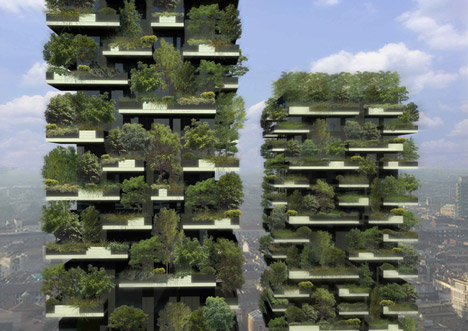
Biological habitats
Vertical Forest increases biodiversity. It helps to set up an urban ecosystem where different kinds of vegetation create a vertical environment which can also be colonised by birds and insects, and thus becomes both a magnet for and a symbol of the spontaneous recolonisation of the city by vegetation and by animal life. The creation of a number of vertical forests in the city will be able to create a network of environmental corridors which will give life to the main parks in the city, bringing the green space of avenues and gardens and connecting various spaces of spontaneous vegetation growth.
Mitigations
Vertical Forest helps to build a micro-climate and to filter dust particles which are present in the urban environment. The diversity of the plants helps to create humidity, and absorb CO2 and dust, produces oxygen, protects people and houses from the suns rays and from acoustic pollution.
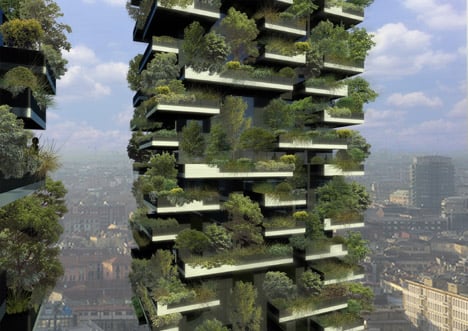
Anti-sprawl
Vertical Forest is an anti-sprawl measure which aims to control and reduce urban expansion. If we think of them in terms of urban densification, each tower of the Vertical Forest is equivalent to an area of urban sprawl of family houses and buildings of up to 50,000 square metres.
Trees
Trees are a key element in understanding architectural projects and garden systems. In this case the choice of the types of trees was made to fit with their positioning on the facades and in terms of their height, and took two years to conclude alongside a group of botanists. The plants used in this project will be grown specifically for this purpose and will be pre-cultivated. Over this period these plants slowly got used to the conditions they will be placed in on the building.creating an adequate micro-climate in order to filter out the sunlight
Vertical Forest is a landmark in the city which is able to release new kinds of variable landscapes which can change their form in each season depending on the types of plants involved. The vertical forests will offer a changing view of the metropolitan city below.
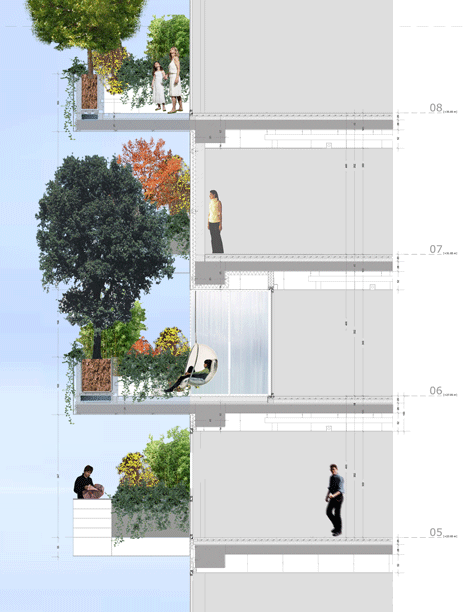
Management
The management of the trees' pots is under building regulation, as well as the upkeep of the greenery and the number of plants for each pot.
Irrigation
In order to understand the need for water the plan for these buildings took into account the distribution of plants across various floors and their positioning.
Architecture: Boeri Studio (Stefano Boeri, Gianandrea Barreca, Giovanni La Varra)
Landscape: Bosco Verticale Landscape Design (Emanuela Borio and Laura Gatti)
Developer: Hines Italia

Supervision of works: Francesco de Felice, Davor Popovic
Design development: Gianni Bertoldi (coordinator), Alessandro Agosti, Andrea Casetto,
Matteo Colognese, Angela Parrozzani, Stefano Onnis
Schematic design and PII: Frederic de Smet (coordinator), Daniele Barillari, Marco Brega,
Julien Boitard, Matilde Cassani, Andrea Casetto, Francesca Cesa Bianchi, Inge Lengwenus,
Corrado Longa, Eleanna Kotsikou, Matteo Marzi, Emanuela Messina, Andrea Sellanes
Structures: Arup Italia s.r.l.
Facilities design: Deerns Italia S.p.A.
Detailed design: Tekne s.p.a.
Open Space Design: Land s.r.l.
Infrastructure design: Alpina S.p.A.
Contract administration (DL): MI.PR.AV. s.r.l.